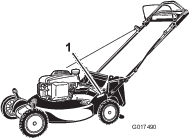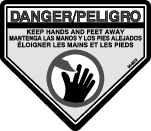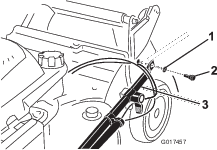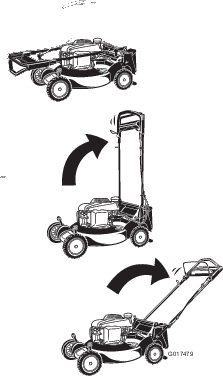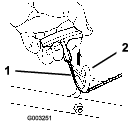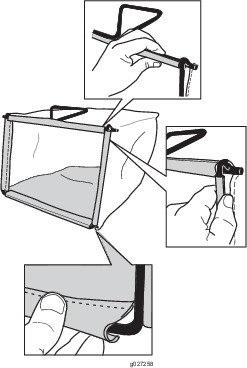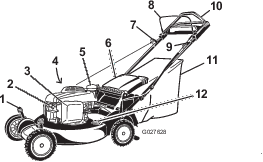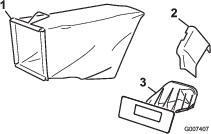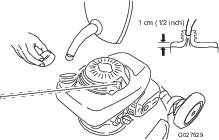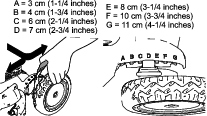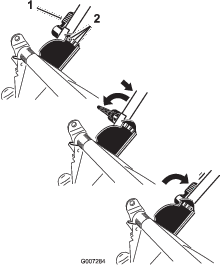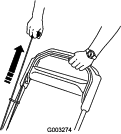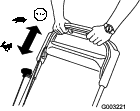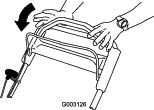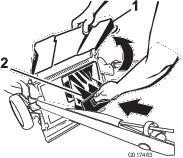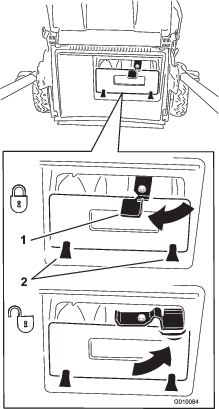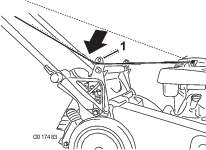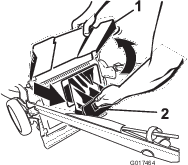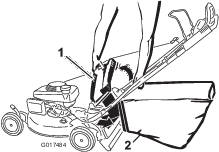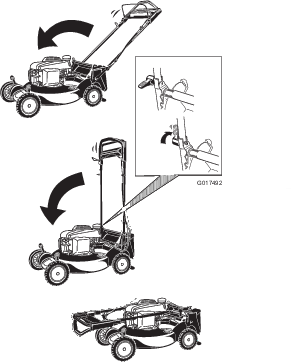Maintenance
Note: Determine the left and right sides of the machine from the normal operating position.
Recommended Maintenance Schedule(s)
| Maintenance Service Interval | Maintenance Procedure |
|---|---|
| After the first 5 operating hours |
|
| Before each use or daily |
|
| Every 25 hours |
|
| Before storage |
|
| Yearly |
|
Important: Refer to your engine owner's manual for additional maintenance procedures.
Preparing for Maintenance
-
Stop the engine and wait for all moving parts to stop.
-
Disconnect the spark-plug wire from the spark plug (Figure 32) before performing any maintenance procedure.

-
After performing the maintenance procedure(s), connect the spark-plug wire to the spark plug.
Important: Before tipping the machine to change the oil or replace the blade, allow the fuel tank to run dry through normal usage. If you must tip the machine prior to running out of fuel, use a hand fuel pump to remove the fuel. Always tip the machine onto its side with the dipstick down.
Warning
Tipping the machine may cause the fuel to leak. Gasoline is flammable and explosive and can cause personal injury.
Run the engine dry or remove the gasoline with a hand pump; never siphon.
Servicing the Air Cleaner
-
Press down on the latch tabs on top of the air cleaner cover (Figure 33).
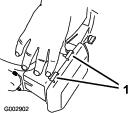
-
Open the cover.
-
Remove the paper air filter (Figure 34).
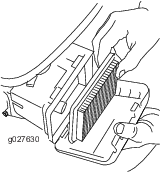
-
If the air filter is damaged or is wet with oil or fuel, replace it.
-
If the air filter is dirty, tap it on a hard surface several times or blow compressed air less than 207 kPa (30 psi) through the side of the filter that faces the engine.
Do not brush the dirt off the filter; brushing forces dirt into the fibers.
-
Remove dirt from the air cleaner body and cover using a moist rag. Do not wipe dirt into the air duct.
-
Install the filter into the air cleaner.
-
Install the cover.
Changing the Engine Oil
Run the engine a few minutes before changing the oil to warm it. Warm oil flows better and carries more contaminants.
-
Perform the pre-maintenance procedures; refer to Preparing for Maintenance.
-
Remove the dipstick.
-
Tip the machine onto its side, with the dipstick down, to drain the used oil out through the oil-fill tube (Figure 35).
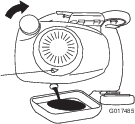
-
After draining the used oil, return the machine to the normal operating position.
-
Remove the dipstick and pour about 3/4 of the crankcase capacity of oil into the oil-fill tube.
Note: Max. fill: 0.55 L (18.6 oz), type: SAE 30 or SAE 10W-30 detergent oil with an API service classification of SF, SG, SH, SJ, SL, or higher.
-
Wipe off the dipstick end with a clean cloth.
-
Insert the dipstick into the oil-fill tube.
-
Remove the dipstick and read the oil level on the dipstick (Figure 36).
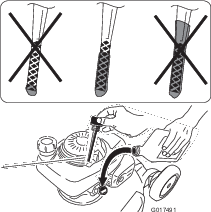
-
If the oil level is too low, add a small amount of oil slowly to the oil-fill tube, and then repeat steps 6 through 8 until the oil level on the dipstick is correct.
-
If the oil level is too high, drain the excess oil until the oil level on the dipstick is correct.
Important: If the oil level in the crankcase is too low or too high and you run the engine, you may damage the engine.
-
-
Install the dipstick securely.
-
Recycle the used oil properly.
Lubricating the Wheel Gears
-
Wipe the grease fittings just inside the rear wheels with a clean rag (Figure 37).
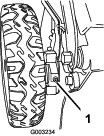
-
Install a grease gun onto each fitting and gently apply 2 or 3 pumps of #2 multi-purpose, lithium-based grease.
Replacing the Blade
Important: You will need a torque wrench to install the blade properly. If you do not have a torque wrench or are uncomfortable performing this procedure, contact an Authorized Service Dealer.
Examine the blade whenever you run out of gasoline. If the blade is damaged or cracked, replace it immediately. If the blade edge is dull or nicked, have it sharpened or replace it.
Warning
The blade is sharp; contacting the blade can result in serious personal injury.
Wear gloves when servicing the blade.
-
Disconnect the spark plug wire from the spark plug. Refer to Preparing for Maintenance.
-
Tip the machine onto its side with the dipstick down.
-
Use a block a wood to hold the blade steady (Figure 38).
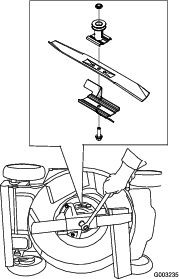
-
Remove the blade, saving all mounting hardware.
-
Install the new blade and all mounting hardware.
Important: Position the curved ends of the blade to point toward the machine housing.
-
Use a torque wrench to tighten the blade bolt to 82 N-m (60 ft-lb).
Important: A bolt torqued to 82 N-m (60 ft-lb) is very tight. While holding the blade with a block of wood, put your weight behind the ratchet or wrench and tighten the bolt securely. This bolt is very difficult to overtighten.
Adjusting the Self-Propel Drive
Whenever you install a new self-propel cable or if the self-propel drive is out of adjustment, adjust the self-propel drive.
-
Turn the adjustment knob counterclockwise to loosen the cable adjustment (Figure 39).
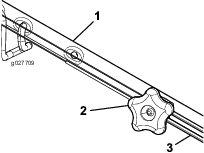
-
Adjust the tension on the cable (Figure 39) by pulling it back or pushing it forward and holding that position.
Note: Push the cable toward the engine to increase the traction; pull the cable away from the engine to decrease the traction.
-
Turn the adjustment knob clockwise to tighten the cable adjustment.
Note: Tighten the knob firmly by hand.
Cleaning the Machine
Warning
The machine may dislodge material from under the machine.
-
Wear eye protection.
-
Stay in the operating position (behind the handle) when the engine is running.
-
Do not allow bystanders in the area.
For best results, clean the machine soon after you have completed mowing.
-
Lower the machine to its lowest cutting-height setting. Refer to Adjusting the Cutting Height.
-
Move the machine onto a flat paved surface.
-
Attach a garden hose that is connected to a water supply to the washout port (Figure 40).
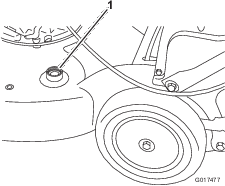
-
Turn the water on.
-
Start the engine and run it until there are no more clippings that come out from under the machine.
-
Stop the engine.
-
Shut off the water and disconnect the garden hose from the machine.
-
Start the engine and run it for a few minutes to dry the underside of the machine.

